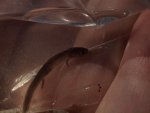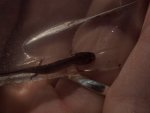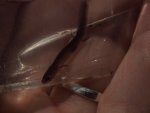Lamb
New member
- Joined
- Feb 28, 2009
- Messages
- 222
- Reaction score
- 12
- Points
- 0
- Age
- 35
- Location
- USA
- Country
- United States
Hello again,
Another weekend of field work has led to finding this little guy in one of the leaf litter traps I put out. I'm at a loss as to what species it is. The head seems very blunt for it to be a Eurycea, but I'm not sure and I'm only just getting my footing in IDing larval stream salamanders. The site is a rather shallow, sandy/pebble bottom stream in a mixed hardwood forest. It's a very hilly place. We've found E. cirrigera and guttolineata there, as well as Desmognathus sp. and Pseudotriton sp. some years before. Any ideas? Please let me know what characters you are basing your suggestion on so I can look for similar traits in the field. I apologize for the poor quality of the pics, I was being swarmed by mosquitoes and the little guy wouldn't stay still for very long.
Another weekend of field work has led to finding this little guy in one of the leaf litter traps I put out. I'm at a loss as to what species it is. The head seems very blunt for it to be a Eurycea, but I'm not sure and I'm only just getting my footing in IDing larval stream salamanders. The site is a rather shallow, sandy/pebble bottom stream in a mixed hardwood forest. It's a very hilly place. We've found E. cirrigera and guttolineata there, as well as Desmognathus sp. and Pseudotriton sp. some years before. Any ideas? Please let me know what characters you are basing your suggestion on so I can look for similar traits in the field. I apologize for the poor quality of the pics, I was being swarmed by mosquitoes and the little guy wouldn't stay still for very long.



